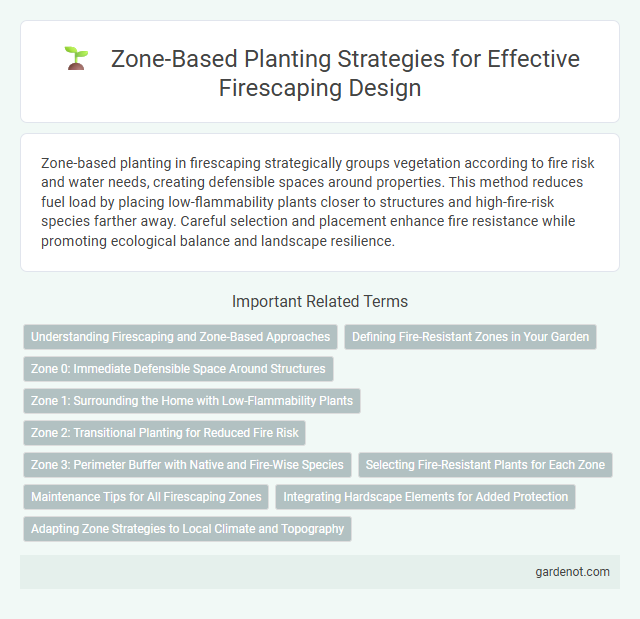Zone-based planting in firescaping strategically groups vegetation according to fire risk and water needs, creating defensible spaces around properties. This method reduces fuel load by placing low-flammability plants closer to structures and high-fire-risk species farther away. Careful selection and placement enhance fire resistance while promoting ecological balance and landscape resilience.
Understanding Firescaping and Zone-Based Approaches
Zone-based planting in firescaping strategically arranges vegetation to create defensible space around structures, reducing wildfire risk by categorizing areas into zones based on proximity to buildings and fire exposure. Each zone incorporates specific plant types and maintenance practices tailored to minimize fuel load, enhance fire resistance, and facilitate safe evacuation. Understanding this approach involves analyzing local fire behavior, plant flammability, and topography to optimize landscape resilience and protect property.
Defining Fire-Resistant Zones in Your Garden
Zone-based planting in firescaping involves creating strategically spaced areas within your garden categorized by varying levels of fire resistance. Defining fire-resistant zones requires selecting low-flammability plants, maintaining proper spacing, and incorporating fire-resistant hardscaping materials to reduce fuel load. Implementing clear separation between high-risk vegetation and your home enhances overall fire defense and increases the effectiveness of emergency response efforts.
Zone 0: Immediate Defensible Space Around Structures
Zone 0 in firescaping refers to the immediate defensible space around structures, typically extending 0 to 5 feet from the building. This zone requires the removal of all combustible materials, including flammable plants, dead vegetation, and debris, to minimize fire risk. Non-combustible, fire-resistant plants or hardscape elements like gravel or stone are recommended to create a safe buffer that protects the structure from ember attacks and radiant heat.
Zone 1: Surrounding the Home with Low-Flammability Plants
Zone 1 firescaping emphasizes planting low-flammability vegetation within 5 feet of the home to create a defensible space against wildfires. Species such as succulents, ornamental grasses, and well-maintained deciduous shrubs reduce fuel load and minimize fire spread near structures. Proper irrigation and regular pruning in this zone enhance plant moisture content, further lowering ignition risk around the residence.
Zone 2: Transitional Planting for Reduced Fire Risk
Zone 2 in firescaping is the transitional planting area located beyond the immediate defensible space, designed to reduce fire risk by using low-fuel, fire-resistant plants. Vegetation in this zone should be carefully selected for its moisture content, spacing, and pruning, with species such as succulents, ornamental grasses, and drought-tolerant shrubs promoting reduced flame spread and ember ignition. Proper maintenance in Zone 2, including removing dead material and thinning dense growth, further mitigates fire hazards and supports overall landscape resilience.
Zone 3: Perimeter Buffer with Native and Fire-Wise Species
Zone 3: Perimeter Buffer in firescaping incorporates native and fire-wise species that create a defensible space by reducing fuel load along property edges. Selecting drought-tolerant plants with high moisture content and low resin levels enhances fire resistance while supporting local ecosystems. Strategic planting in this zone forms a natural barrier that slows fire spread and protects structures from advancing wildfires.
Selecting Fire-Resistant Plants for Each Zone
Selecting fire-resistant plants for each zone in firescaping involves choosing species with low flammability, high moisture content, and minimal resin or sap. Zone-based planting requires creating defensible space by grouping plants with similar fire resistance, typically arranging low-growing, fire-resistant shrubs and groundcovers near structures and placing less flammable trees farther out. Proper selection and placement of fire-resistant plants reduce fuel availability and slow fire spread, enhancing property protection during wildfires.
Maintenance Tips for All Firescaping Zones
Zone-based planting in firescaping requires tailored maintenance strategies to enhance fire resistance and plant health across diverse fire risk areas. Prioritize regular pruning and removal of dead or dry vegetation, especially within high-risk zones, to minimize fuel load and maintain defensible space. Implement seasonal irrigation and soil enrichment practices adjusted to each zone's specific plant types and microclimate, ensuring optimal growth while reducing fire hazards.
Integrating Hardscape Elements for Added Protection
Zone-based planting enhances fire protection by strategically integrating hardscape elements such as stone pathways, gravel beds, and retaining walls to create effective fuel breaks. These non-combustible barriers disrupt fire spread while complementing fire-resistant plant selections within defensible zones. Incorporating hardscape materials tailored to local fire codes significantly increases the resilience of the landscape against wildfire damage.
Adapting Zone Strategies to Local Climate and Topography
Zone-based planting adapts fire-resistant vegetation to the specific microclimates and topographical features of a property, reducing wildfire risk by creating defensible spaces in strategic locations. By assessing slope, wind patterns, and sun exposure, homeowners can select plants optimized for moisture retention and fire resistance suited to each zone's environmental conditions. Tailoring plant choices to local climate variations ensures increased resilience and effectiveness in fire mitigation efforts.
Zone-based planting Infographic

 gardenot.com
gardenot.com